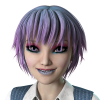Need UV Mapping Help
 Faeryl Womyn
Posts: 3,663
Faeryl Womyn
Posts: 3,663
I saw a thread here the other day that, if I understood it corretly, you can use Daz to get a uvmap. Since I am using the dynamic clothing, not all have a uvmap, or even an obj to I can use to get one. Sometimes, I will use a texture already made as a guide for a map, but what to do when there are no textures to do that with.?
Does anyone know of this thread or maybe correct me if I misunderstood and can offer any suggestions?


Comments
If the obj has been uv mapped in either a dedicated uv mapping app or in a modelling app, DS can save the UV map to it's list that you use to swap out uv maps between figures.
DS does not have the tools to create a uv map. You can download uv mapper classic which is free and create a uv map for the obj file if it hasn't been uv mapped.
Poser Prop files (pp2) have obj files, they are just embedded in the pp2. Even if the file is a duf, there is an obj file somewhere.
You can use a procedural texture on a non-uv mapped obj.
You can get a template of sorts using D/S.
Not with a bunch of lines mind you.
With the item loaded, create turn on a bunch of lights for top, bottom, each side, back and front.
Then over on the Surface Tab, having "everything selected" go to the Baked option.
Do not apply them to the figure ... [but later dig them out of the folder [I'd suggest making one where it tends to offer first look in its folders, not the temp folders]] ... and save to .png.
Make sure 'turn illumination' [or whatever it's called now] is turned on. Have each baked to their own page ... unless you know and/or what them all on the one page.
And bake 'em.
The results usually include a buffer zone too. [aka seam allowance]
edit to add: if you applied a texture with a lot of stripes, you'll get something of a guide for where the seams meet ;-)
Lighten/darken images in your image editor and have fun!
You can't render it like that but you can take a screen shot..
Ok will check these out when I get home later. In the meantime. when it comes to the duf and the pp2, how do I get the obj from them?
UV mapper Classic.
http://www.uvmapper.com/downloads.html
Read the tutorials and play with the extra obj files included. One of the important helper apps.
Roadkill
http://www.pullin-shapes.co.uk/page8.htm
Download the Maya version. Though it doesn't look like it, it has a stand alone version. There are tutorials for using it in a Poser workflow which can easily be adapted to anyone's workflow. It's also free.
If you have a copy of Poser, the easiest way is to load the prop into the viewport and the export the prop out as an obj file. Export as single frame. When the list pops up make sure the universe and ground are unchecked. If the obj is ungrouped, you should only have two boxes filled in. If it is grouped, there will be a third in the sub heading of the second box. Just hit ok, give it a name so you know what it is and tell it where to save it.
Come to think of it (my brain is slow today) you should be able to export the obj out of DS pretty much the same way. Load the duf prop in DS and export as an obj. If it is a prop that was created in Poser you may have to adjust size. If the pp2 file was saved and then packaged using the Poser Native Units (which are about 8 feet) rather than DS default of 1cm, the prop will be large. You may have to adjust in it in the export settings.
UVMapper Classic also handles PP2s with internally-coded geometry.
I don't have poser, well actually I have poser6 but it refused to even install on my computer. uv classic I have. The items are not props, they are clothes, or at least the one's I currently would like to make textures for are Opitex free dynamic clothes. Some of them did not even come with textures or I would have those images to use as a map of sorts. The pp2 info would be good for future use, but right now am interested in the Opitex clothes that don't have a map, an obj or even a texture image I can fall back on.
My method works perfectly for Optitex stuff and you don't have to export anything.. you can export them as an .obj and get the uv map with uv mapper classic, but unless you need absolute pixel accuracy at 4000x4000 the in DS way is plenty fine.
Ok, different story with Optitex dynamic clothing. They do have a uv just not a "normal" as in what you are used to. Remember, the Optitex system is actually a real world patter creator. The software takes a template that looks like a real world clothing pattern and stitches it together.
Because the template uses real world pattern pieces, the texturing is different than you would find for something like the morphing fanatasy dress.
I don't have any Optitex pieces installed but have you looked in the runtime folder inside the content folder inside the my library folder? Many times I find textures end up there.